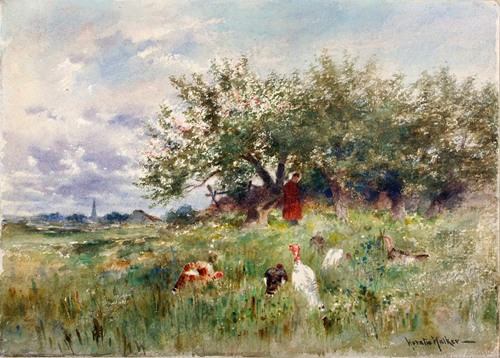
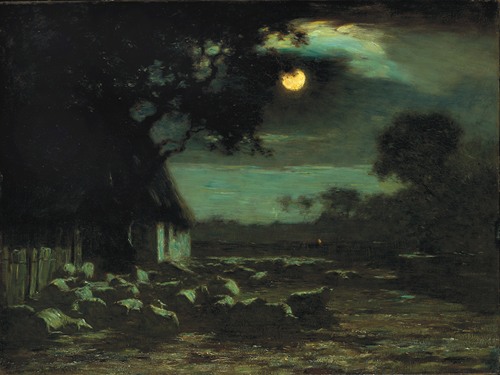
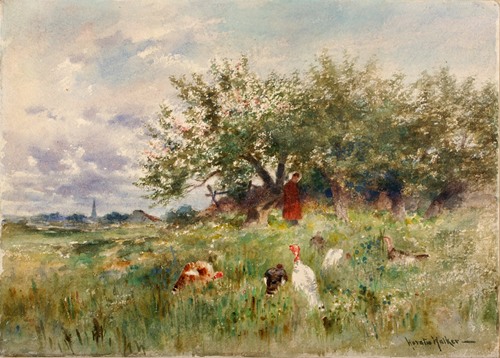
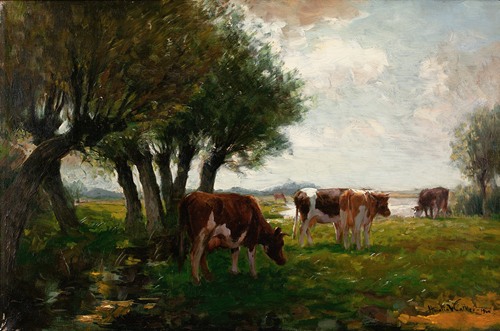
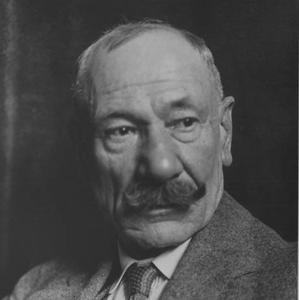

Horatio Walker RI RCA was a Canadian painter. He worked in oils and watercolours, often depicting scenes of rural life in Canada. He was influenced by the Barbizon school.
Walker was born in 1858 to parents Thomas and Jeanne Maurice Walker. Thomas Walker emigrated in 1856 from Yorkshire, England, to Listowel, Ontario, with his wife of French and English heritage. Having some wealth, Thomas purchased land for lumber in Midwestern Ontario and Horatio was raised in relative comfort. His interest in art may originate from his father who crafted small figures as a hobby, and both his father and the local school teacher encouraged drawing as a pastime.
In 1870, on Walker's 12th birthday, his father brought him to Quebec City, Quebec, for the first time. His father made occasional business trips to the city as part of his timber business. During this sojourn, they visited the Île d'Orléans, in search of pine timber. Walker made subsequent visits to Quebec City during the following years. His formal schooling ended at the Listowel Public School in 1872; he never went on to pursue formal academic training in art. At the age of 15, Walker moved to Toronto, Ontario to apprentice with the photographic firm Notman and Fraser. It was a fortunate opportunity, as several successful artists also worked there; Walker learned watercolour from Robert Ford Gagen, miniature portrait painting from John Arthur Fraser, and painting from Lucius Richard O'Brien and Henri Perré.
Walker was only at the firm for three years until he moved to the United States of America for uncertain reasons. Writing in 1928, Hector Charlesworth suggested that Walker was "chucked down the stairs" and fired for quarrelling with a family relative. However, it is more likely that Walker travelled to Philadelphia for the American Centennial in 1876, an exhibition where Notman and Fraser won the international award, which gave the firm the privilege of exclusive photographic rights for the celebrations. Ultimately, Walker may have decided to stay and pursue painting.
During the period of Walker's life around 1878, he would have become familiar with the painters of the Barbizon school, which were at the time, exhibited in American museums and galleries. In 1880, Walker made an extended trip to Europe to learn more about Barbizon methods, and its agrarian subject matter, that would come to define his painting for the rest of his life.
What happened with Walker during the two following years remains vague, but in 1878, he opened a studio in New York City. During the 1880s, Walker's parents moved to Rochester, New York, and Walker participated in the founding of the Rochester Art Club. A further sign of Walker's growing success was an invitation to join the American Watercolour membership in 1882. In 1883 he married Jeanette Pretty (died 1938) of Toronto. They had two children, Alice (1884–1891) and Horatio Jr. (1886–1910). It was sometime during this period that Walker purchased a residence on Île d'Orléans in the village of Sainte-Pétronille. From now on until his retirement, Walker would spend his summers in Quebec and winters in his New York City studio.
Walker's personal life was disastrous: his daughter died of diphtheria, his son of tuberculosis and his wife Jeanette, was committed to hospital permanently in 1914 due to paranoia. These tragedies do not seem to have influenced his painting; Walker's subject matter and style remained constant throughout his career without much variation.



